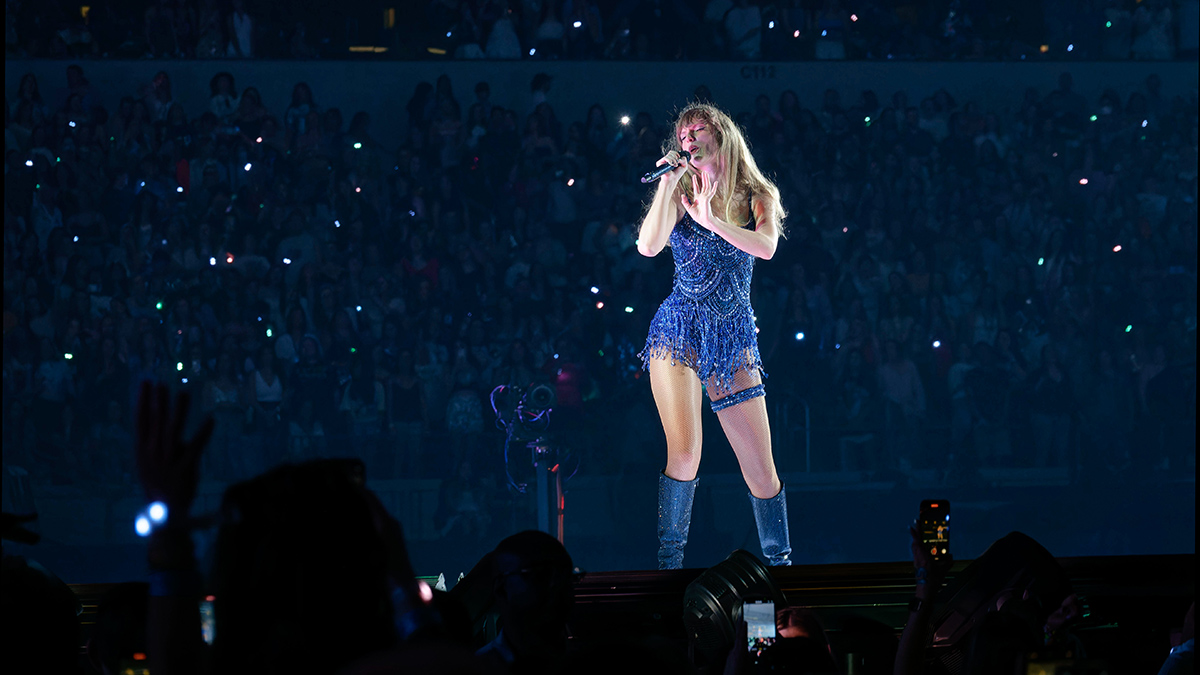When 70,000 fans bounced up and down to Taylor Swift last year, the ground pulsed with them, making distinct spikes in seismic signals that many referred to as Swift quakes. Scientists have now analyzed the tremors to learn about their source.
Researchers have debated what causes these types of seismic signals at large events, said Gabrielle Tepp, a seismologist at the California Institute of Technology in Pasadena. Some argued that it’s crowd motion, whether that be dancing at a rave or jumping at a football game. Others suspected that the blaring music itself is the cause.
Tepp and her colleagues took advantage of an August 2023 series of Taylor Swift concerts in Inglewood, Calif., to investigate. The team deployed seismic sensors in and near SoFi Stadium, where Swift performed, and gathered data from the regional seismic monitoring network.
In the basement of their university building on a Sunday morning, when there were few people around to bother, they cranked up Swift songs.
For one of the concerts, the team plotted the intensity of the seismic signal over time and a range of frequencies on what’s known as a spectrogram. A natural earthquake produces a continuous range of frequencies on a spectrogram and typically has a sharp beginning that tapers off in intensity. That was not the pattern at the Swift concert, whose spectrogram instead contained segments of fairly uniform intensity at characteristic frequencies.
The researchers matched that pattern to the set list based on tunes’ start times, durations, and beat rates. Each song typically had a seismic frequency that synced up with the song’s beat rate as well as its harmonics, which have frequencies that are multiples of the beat rate.
To investigate the origin of the harmonics, Tepp and her colleagues experimented with the potential factors at play: music and human motions. In the basement of their university building on a Sunday morning, when there were few people around to bother, they cranked up Swift songs. They played one of the bouncier songs, “Love Story,” with a seismic sensor next to the speaker. That didn’t produce the characteristic spectrogram.
Then Tepp jumped up and down next to the sensor and the speaker. “It gave a very nice harmonic signal,” she said, suggesting that the motion of jumping fans produced the curious seismic signals. The researchers published their findings in Seismological Research Letters.
Quake It Off
The concert data also revealed that the most intense seismic signals came during Swift hits “Shake It Off,” “You Belong with Me,” and “Love Story.”
Compared with Metallica, Morgan Wallen, and Beyoncé concerts, which were also recorded by seismic sensors near SoFi Stadium, Swift’s concerts had the most intense seismic signals. Tepp said she suspects the differences may stem from how danceable the music is. Beyoncé’s show started with ballads, to which concertgoers may have swayed rather than jumped. Likewise, the typical motions of Metallica’s metal fans may not make steady, repeating vibrations like the ones made by pop fans.
“In no way, shape, or form is this the kind of thing we normally consider when we talk about earthquake magnitude.”
People are often curious about the magnitude of this type of ground shaking and how it might compare with earthquakes, said Jackie Caplan-Auerbach, a seismologist at Western Washington University in Bellingham who wasn’t involved with the study. But “in no way, shape, or form is this the kind of thing we normally consider when we talk about earthquake magnitude,” she said. “The concept of magnitude is very much wrapped up in the physics of how earthquakes shake the ground.” This crowd motion isn’t happening underground or on a fault. Nor does it break the rock or make it slip.
Some measures of an earthquake’s effect would be tricky to translate to swaying or dancing Swifties, but the researchers reasoned that both types of events release energy into the ground. On the basis of the spectrograms, the researchers determined the energy released by concertgoers and used this to calculate an equivalent magnitude for each song. The greatest of these was 0.85.
With a motion sensor inside the stadium, the team also observed the intensity of shaking. The strongest shaking was between II and III on the Modified Mercalli Intensity Scale. “It’s not going to be super strong, but you would definitely feel it,” Tepp said.
The magnitude calculation is a “unique contribution” to the field, Caplan-Auerbach said. She and her colleagues published a separate study in GSA Today in March analyzing several of Swift’s concerts in the Seattle area. The group compared seismic signals from the preconcert sound check, the concert with jumping fans, and Swift’s acoustic set during which the band doesn’t play. Their findings largely echoed the study from Tepp and her colleagues. “The strongest ground shaking is definitively caused by the crowd,” Caplan-Auerbach said.
The seismic spikes caused by jumping fans resemble the repetitive trembles of earthquake swarms, Tepp said. And volcanic systems often have harmonic signals associated with gases or magma traveling through a conduit. Studying harmonics from crowds could provide clues for seismologists figuring out how to identify these unusual signals in seismic data.
—Carolyn Wilke (@CarolynMWilke), Science Writer
This news article is included in our ENGAGE resource for educators seeking science news for their classroom lessons. Browse all ENGAGE articles, and share with your fellow educators how you integrated the article into an activity in the comments section below.



